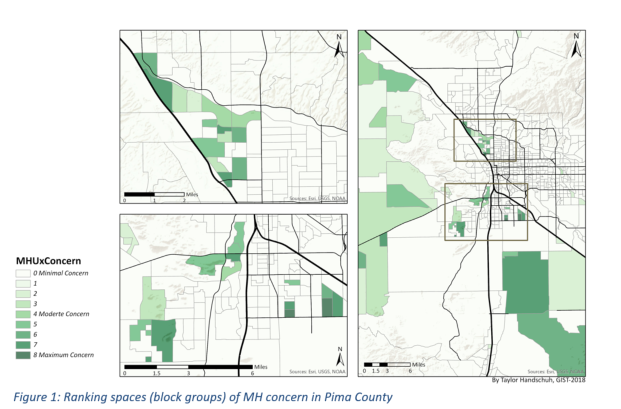Where in Tucson do insecurity and manufactured housing overlap?
The growing need for affordable housing has sparked renewed interest in manufactured housing (MH) as a way to expand housing options for low-income populations. However, MH remains an understudied, often denigrated form of housing whose residents are subject to unique forms of social, financial and environmental insecurity. These insecurities are especially important to understand in Metro Tucson (Pima County)1 where roughly 10% of all housing units are mobile/manufactured homes—more than twice the percentage found in peer metropolitan areas Phoenix (4.8), Las Vegas (3.3), Portland (4.4) or Los Angeles (1.6) (AHS 2013, 2015).
MH is not an inherently insecure form of housing. However, in Metro Tucson, there is often a wide gap between the merits and promise of MH in theory, and how MH is lived in and experienced by residents. We call this disjuncture between promise and reality the “MH gap”.
This white paper provides insights into the nature and origins of the MH gap in Tucson, but also allows for the identification of specific areas of the city and county in need of the most attention from public and non-profit service providers, resident advocates, industry groups, and researchers.
Key findings:
What are the origins of the MH gap?
- The present geography of MH distress and socio-economic insecurity is deeply imbricated with the geography of the boom in MH permit issuance and shipments in the 1960s/1970s.
- Thirty-five percent of Pima County’s MH stock is pre-1976 MH typically built with hazardous materials (e.g. asbestos and formaldehyde), poor insulation and fire-prone aluminum wiring.
- The divided ownership structure of MH allows for several distinct tenure arrangements (e.g. own MH, rent land; rent MH, rent land; own MH, own land, etc.) each with its own particular geographies and consequences (both positive and negative) for MH residents.
- Most research on the risks and insecurities of divided ownership focuses on “mobile home parks” or “trailer parks”; however, the insecurities of MH extend well beyond “park gates”.
Factors related to the MH gap are not isolated to mobile home parks
- Two-thirds of all MH in Pima County is not located in “parks”. Approximately 52% of MH located outside of parks in Pima County is personal property – not real property. Non-park MH is often located in similar geographic milieus as MH parks.
- MH titled as real property in Pima County can be associated with mortgage interest rate premiums.
Where is the MH gap most severe?
- In Pima County, MH is predominantly found in urban areas, with especially large clusters found near the City of Tucson’s borders with unincorporated Pima County. The Flowing Wells cluster contains two units of MH for every five adults.
- Heuristic mapping can be used to identify “spaces of most concern” where concentrations of MH and indicators of socio-economic insecurity overlap the most (Figure 1). Spaces of most concern are concentrated in: i) the Flowing Wells area; ii) between Interstate 10 and Tucson International Airport; and iii) along the Santa Cruz River / Interstate 19 and Ajo Way.

These preliminary findings, while significant, require additional complementary data to produce a more robust assessment beyond what is possible from the analysis of spatial correlations between proxy variables and MH available through public data sources. Figuring out what the most important determinants of MH insecurity are, and how these determinants should be measured, mapped, and weighted, requires qualitative research.
[1] The Tucson Metropolitan Statistical Area is the same as Pima County.












